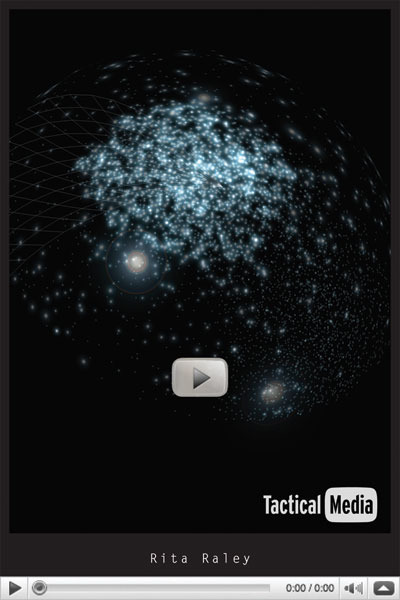Tactical Media
Rita Raley’s Tactical Media covers the “spectrum ranging from direct action (e.g., denial-of-service attacks and game space interventions) to symbolic performance (e.g., data visualization)” (150). Raley ties together a movement which eschews grand narratives and the contrapuntal teleological declarations of manifestos, identifying a strain of media activism that is, to use deCerteau’s term, “tactical”. What ties these practices together is a combination of “virtuosic performance and cultural critique” (Raley 150). As Raley maintains, and as the work reflects, tactical media is characterized not by its ability to instigate a widespread revolution, rather it is in the ability of relatively powerless operators, through skill and creativity, to turn systems of power against themselves, exposing, however fleetingly, the illegitimacy and injustice of their own authority.
The text covers three chief thematic areas which are seem to roughly characterize the dominant subjects of tactical media: Chapter 1: Border Hacks (which addresses the vast pool of tactical media that has arisen to critique the politics of globalization and human migration), Chapter 2: Virtual War (which focuses on those works which exist to raise critical consciousness about war and conflict), and Chapter 3: Speculative Capital (which deals with works that aim to shed light on the practices of global financial markets). In addressing these three areas, Raley does not necessarily confine “tactical media” to such subject matter, rather she highlights the chief discursive threads whose point of convergence to form a critique of neoliberalism. Here is where this activist movement is able to establish its center, if it can be said to have one at all.
But beyond offering a useful delineation of “tactical media” and a strong theoretical frame from which it can be understood, Raley’s work points to the limitations of such work. In reviewing the corpus of works selected and the movement’s general rejection of generalities in favor of short term, ephemeral, and technologically facilitated acts of opposition, one cannot help but notice the tension that exists between an art movement that is overwhelmingly in solidarity with the dispossessed, yet seems to resist statements of solidarity in theoretical matters, which believes in the power of art and the symbolic to intervene in the construction of reality, yet doubts the possibility of human-generated interventions we call revolutions.
---
Tactical media describes interventionist media art practices that engage and critique the dominant political and economic order. Rather than taking to the streets and staging spectacular protests, the practitioners of tactical media engage in an aesthetic politics of disruption, intervention, and education. From They Rule, an interactive map of the myriad connections between the world’s corporate and political elite created by Josh On and Futurefarmers, to Black Shoals, a financial market visualization that is intended to be both aesthetically and politically disruptive, they embrace a broad range of oppositional practices.
In Tactical Media, Rita Raley provides a critical exploration of the new media art activism that has emerged out of, and in direct response to, postindustrialism and neoliberal globalization. Through close readings of projects by the DoEAT group, the Critical Art Ensemble, Electronic Civil Disobedience, and other tactical media groups, she articulates their divergent methods and goals and locates a virtuosity that is also boldly political. Contemporary models of resistance and dissent, she finds, mimic the decentralized and virtual operations of global capital and the post-9/11 security state to exploit and undermine the system from within.
Emphasizing the profound shift from strategy to tactics that informs new media art-activism, Raley assesses the efficacy of its symbolic performances, gamings, visualizations, and hacks. With its cogent analyses of new media art and its social impact, Tactical Media makes a timely and much needed contribution to wider debates about political activism, contemporary art, and digital technology.
(Source: University of Minnesota Press catalog copy)
Critical writing that references this:
Teaching Resource using this Critical Writing:
| Resource | Teaching Resource Type | Author | Year |
|---|---|---|---|
| Authoring 2.0: Writing Digital Culture (ENGL 5380-001) | Syllabus | Carolyn Guertin | 2012 |


